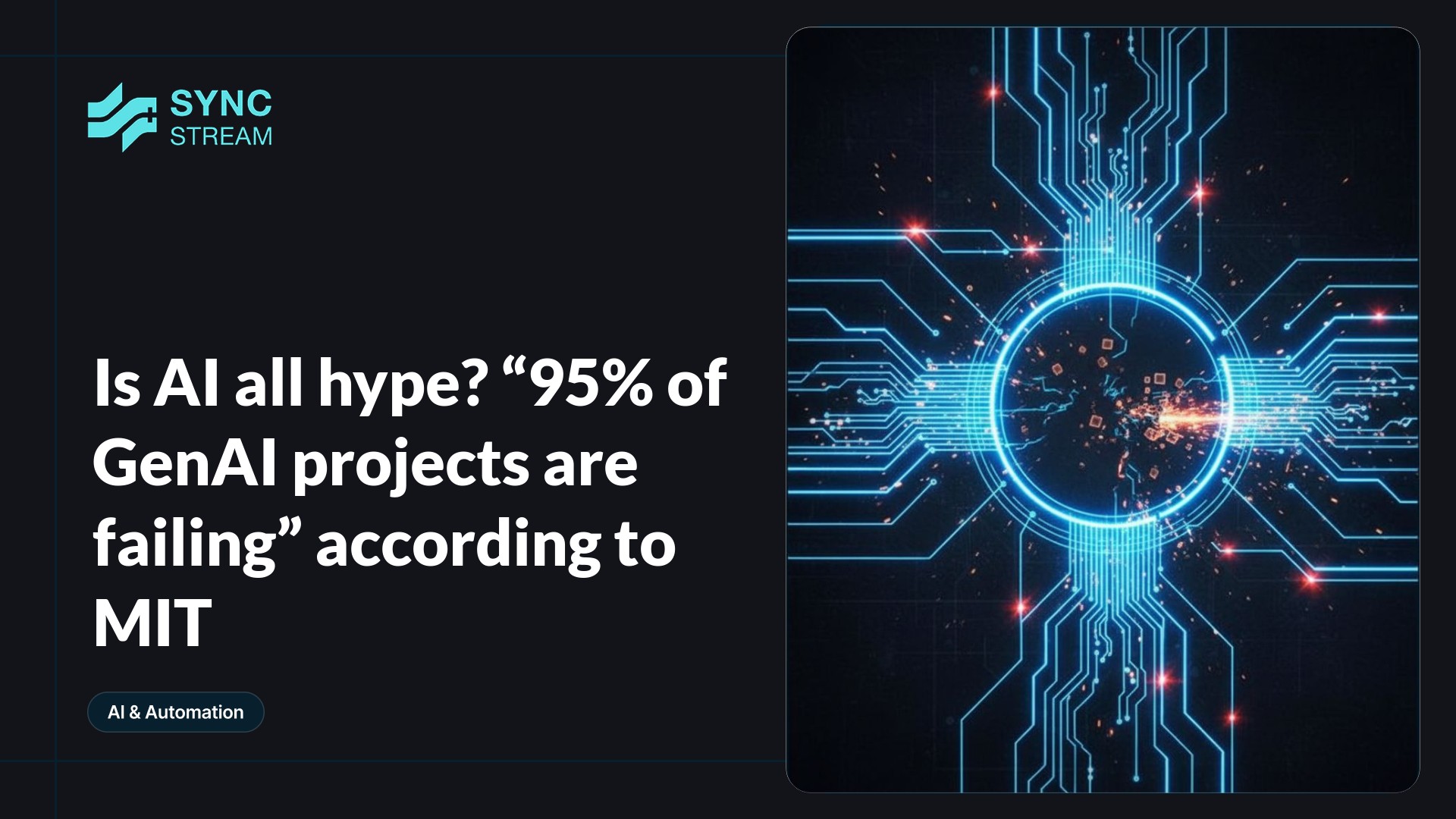
A headline has been doing the rounds: 95% of GenAI projects are failing. It’s attention-grabbing, but what’s really behind that number? At Sync Stream, we read beyond the headlines. Here’s what the research says—and what it means for businesses serious about AI.
What is this “95% failure” claim based on?
This figure doing the rounds recently derives from a 2025 MIT study, “The GenAI Divide: State of AI in Business 2025.” It found that 95% of enterprise-level generative AI pilot programs failed to deliver measurable business impact or ROI across 300 AI deployments, 150 leadership interviews, and 350 employee responses. MIT attributes the failures not to the AI itself, but to a “learning gap” within organisations—namely their inability to adapt processes, systems, and culture to leverage AI effectively. (TechRadar, Investors)
But here at Sync Stream, knowing how powerful this technology is, we actually read the report and not just the headlines to dig that little bit deeper...
Key drivers of failure:
- Cultural and organisational misalignment: AI tools weren’t integrated into workflows or supported by leaders.
- Misallocated budgets: Firms often prioritised sales and marketing, whereas ROI was higher in back-office automation. (TechRadar)
- Overambition/hype: Many projects lacked realistic objectives or scaled prematurely. (WebProNews, AInvest)
- In-house vs vendor disparity: Vendor tools have success rates of 20–30%, whereas bespoke internal AI systems failed more than 95% of the time. (WebProNews)
Here's our Sync Stream view: we always work with the busines owners and executives to start. This is intentional to drive organisational change. We also have not yet accepted a client (bar one admittedly) who started on sales and marketing. Intentional again. The work that companies like us here at Sync Stream is not the next generation of a marketing agency. It is not a CFO signing off on spend X and get Y more leads. It is process optimisation and significant productivity gains. The simplistic transactional ROI modelling won't cut it.
Is this a perception or reality?
But look the report is from a baseless opinion—it's a snapshot of enterprises mismanaging GenAI adoption. But…
- “Failure” doesn’t necessarily mean complete flop: Many pilots simply didn’t move beyond proof-of-concept into financially meaningful outcomes. (AInvest)
- It's context-specific: This applies to large-scale, enterprise-level GenAI pilots, not every AI project across industries or use cases.
So yes—the failure rate is real within that specific scope. But the headline oversimplifies a complex reality.
What about broader AI failure statistics?
Other research casts a wider net:
- RAND (2024): Over 80% of AI/ML projects fail—double the failure rate of non-AI tech projects. Causes include misaligned goals, insufficient data, infrastructure gaps, and overusing hype rather than solving real problems. (TechRadar, RAND Corporation)
- TechRadar summary of RAND: Highlighted that only 14% of organisations felt ready for AI; failure stems from poor communication and unrealistic ambitions. (TechRadar)
- Gartner/VentureBeat via Forbes: Claims around 85% of AI models/projects may fail, often due to low data quality. (Forbes)
- Everest Group/Forbes: Suggest around 90% of GenAI pilots don’t reach production in enterprises. (Forbes)
So enterprise AI projects struggle for structural, not technical, reasons—governance, data, leadership, and execution.
Summary Table
Challenge your thinking
You might be assuming this is a problem with GenAI technology. But the issue lies elsewhere:
- Do you believe technology is the root? Evidence suggests failure stems from organisational readiness.
- Could some industries or organisations buck this trend? Start-ups or entities with highly focused problems—rather than jack-of-all-trades ambitions—are faring better. (RAND Corporation, nanda.media.mit.edu, WebProNews, Forbes, projectmanagementworks.co.uk)
Reframing the narrative
Rather than dismiss the numbers, let's push for specificity:
- What defines "failure"? Is it lack of ROI? Absence of scale?
- Which industries or departments show promise? Back-office automation sees high ROI. (TechRadar)
- What's the alternative? Leaner, purpose-driven pilots, strong data governance, clear KPIs, and realistic resourcing.
Final takeaway
That 95% headline represents a high failure rate—but one filtered through a lens of poorly designed, poorly integrated enterprise pilots. The real issue isn’t a flawed AI model, but flawed organisational strategy. Treat it as a hypothesis, not a conclusion.
If you want to sharpen your thinking: ask whether failure is systemic at your organisation—or a limitation of how you're measuring success. Then test pilots against focused metrics, not hype.
